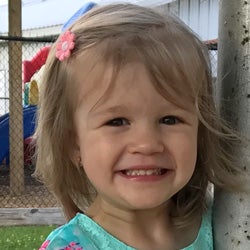Stage IV Intermediate Neuroblastoma
When 13-month old Michaela Hicks randomly started running a fever, her mother, Dana, knew there was more going on than a simple fever virus. However, test after test performed at the pediatrician’s office came back normal. “After a couple of weeks she still had the fever and she was getting listless and pale,” Dana said. “I knew I had to get her to the hospital that day or she might not make it.” Dana took Michaela to the local emergency room, where after a couple of incorrect diagnoses, an ultrasound revealed what looked like a mass on her liver. A follow-up CT scan showed not a mass on her liver, but a mass behind it taking up her abdomen and reaching up near her heart. “Everything that was supposed to be in her abdomen was pushed to her left hip bone,” Dana said. “The growth was massive.” Michaela was diagnosed with stage IV neuroblastoma, the most common type of cancer in infants. The mass wrapped around Michaela’s aorta and inferior vena cava. Once again listening to her instincts, Dana made the call to move Michaela from the local hospital to Children’s of Alabama for treatment. After a five-hour ambulance ride from Mobile, Dana and husband David were met by a number of doctors who assessed Michaela’s condition and assembled a plan. “I immediately was comforted and knew that Children’s was where she was supposed to be,” Dana said. “From the very beginning we felt safe and loved.” During Michaela’s first week at Children’s, doctors did a biopsy of the mass and started Michaela on chemotherapy. “Initially they thought she had about a 20 percent chance of survival,” Dana said. “She really wasn’t expected to make it. But thankfully the biopsy revealed she was at intermediate risk instead of high risk, increasing her survival rate to 80 percent.” Michaela underwent three rounds of chemo and tests showed the mass shrank dramatically. The original plan was for Michaela to have surgery soon after that to remove the tumor, but since it responded so well to chemo, Michaela had all eight rounds of chemo before surgery. “When they did the surgery, they were able to remove about 90 percent of it,” Dana said. “There was some wrapped around her arteries and veins that feed the intestines, so the surgeon didn’t feel comfortable getting the last of it so as not to risk serious damage hurting her arteries.” While a small amount of the tumor remains, Michaela is faring well. She’s not in remission, but is considered stable. In between trips to Birmingham every few months for doctors to monitor the tumor, now 3-year-old Michaela is busy in her dance classes—ballet, tap, and hip-hop—and striving to keep up with her big sister, Isabella. “Michaela has been through so much and she has been a trooper,” Dana said. “The outcome wouldn’t have been the same without the doctors and nurses at Children’s. There is no doubt that Children’s is where she was supposed to be.”







